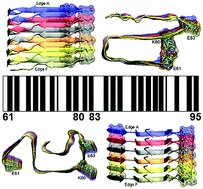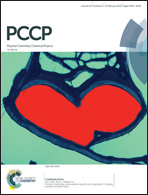The fold preference and thermodynamic stability of α-synuclein fibrils is encoded in the non-amyloid-β component region†
Abstract
The heterogeneity of the synucleinopathies, neurological disorders that include Parkinson's disease (PD), indicates that toxicity, seeding/cross-seeding ability, and propagation of α-synuclein (αS) assemblies depend on their distinct structural characteristics or “strain”. To examine the molecular signature that encodes the aggregation seed, conformational preference, and thermodynamic stability of full-length αS fibrils, we performed molecular dynamics simulations on two non-amyloid-β component (NAC) fibril structures, containing residues 61–95 of two distinct αS fibrils. We identified several discrete hot spots in the recognized hydrophobic core of NAC (residues 68–82) that could initiate the early assembly of αS. We show that NAC fibrils inherit the preferred fold of their parent αS fibril, but could switch conformational preference in two fibril mutants K80Q and E83Q under different solution conditions. Similar to αS fibrils, NAC fibrils are also sensitive to temperature and salt concentration. The favorable solvation free energy of NAC fibrils at low temperature (280 K) suggests a propensity for cold-denaturation. Our results indicate that the strain-dependent synucleinopathies may be partially imprinted in the fold-dependent thermodynamic properties of NAC fibrils, providing structural insights into the emerging development of anti-PD treatments that target the NAC region of αS.



 Please wait while we load your content...
Please wait while we load your content...